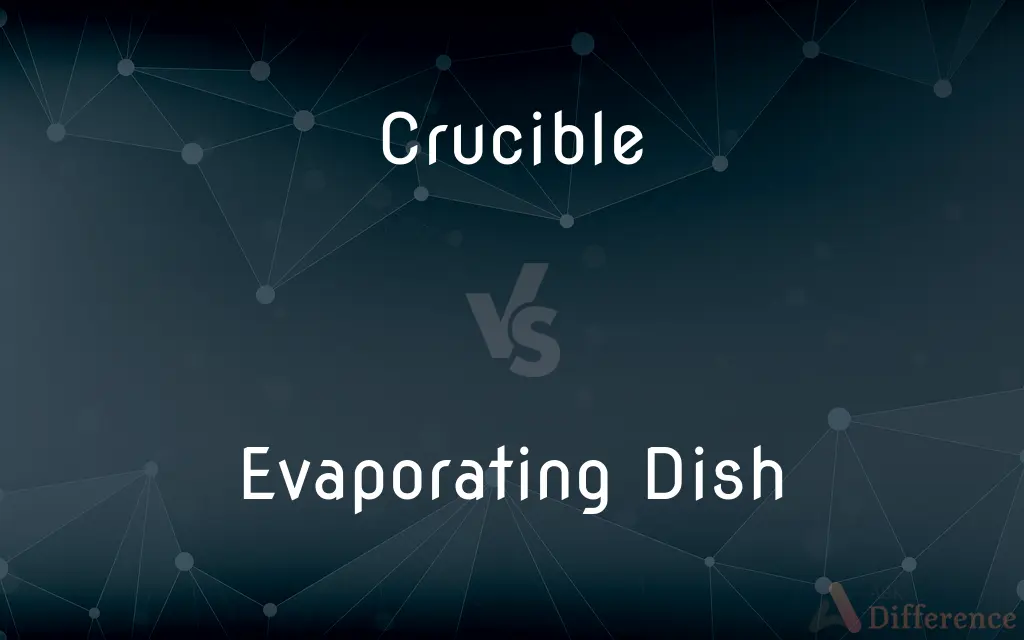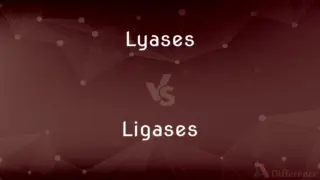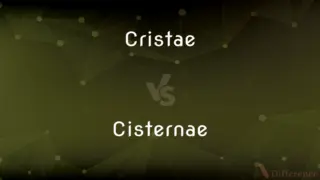Crucible vs. Evaporating Dish — What's the Difference?
Edited by Tayyaba Rehman — By Maham Liaqat — Published on February 23, 2024
A crucible is designed for heating substances to very high temperatures without contamination, while an evaporating dish is used to gently evaporate solvents and concentrate solutions.

Difference Between Crucible and Evaporating Dish
Table of Contents
ADVERTISEMENT
Key Differences
Crucibles are made from materials that can withstand extremely high temperatures, such as porcelain, quartz, or platinum, making them ideal for melting or ashing substances. They are typically used in applications where high heat resistance is crucial, such as in metal casting and chemical analysis. In contrast, evaporating dishes are usually made of porcelain or borosilicate glass and are used for evaporating solvents, usually at lower temperatures. They facilitate the slow evaporation process, which is essential in preparing concentrated solutions or in the drying of precipitates.
Evaporating dishes have a wide, shallow form to increase the surface area for evaporation, enhancing the evaporation rate. This design is particularly useful for concentrating solutions without the need for high temperatures. Crucibles, on the other hand, often have a higher form with a lid to contain substances at high temperatures and prevent contamination from the environment, which is not a design feature prioritized in evaporating dishes.
In terms of application, crucibles are essential in laboratories for tasks requiring high-temperature resistance, such as determining the melting points of metals or conducting gravimetric analysis. Evaporating dishes, however, are more commonly used in processes like crystallization, where a solvent is evaporated to leave behind a solid residue.
The choice between a crucible and an evaporating dish depends on the specific laboratory needs: high temperature and contamination prevention for the former, and effective solvent evaporation for the latter. This decision impacts the experiment's efficiency, safety, and outcome.
Both are crucial laboratory apparatuses, their care and handling differ due to their distinct functions and material compositions. Whereas Crucibles require conditioning before first use, especially when used at very high temperatures, to prevent cracking. Evaporating dishes, while also needing careful handling, primarily require gradual heating to avoid thermal shock and ensure a long service life.
ADVERTISEMENT
Comparison Chart
Material
Made from materials resistant to very high temperatures (e.g., porcelain, quartz, platinum)
Typically made of porcelain or borosilicate glass
Purpose
Used for melting or ashing substances at high temperatures without contamination
Used for gently evaporating solvents to concentrate solutions or dry precipitates
Design
High form with a lid to contain substances and prevent contamination
Wide, shallow form to increase surface area for evaporation
Temperature Resistance
Can withstand extremely high temperatures
Designed for use at lower temperatures
Typical Use
Metal casting, chemical analysis, determining melting points
Concentrating solutions, crystallization, drying of precipitates
Compare with Definitions
Crucible
A container for heating substances to high temperatures without contamination.
The chemist used a crucible to melt a sample of pure gold.
Evaporating Dish
Typically made of porcelain or borosilicate glass.
The borosilicate evaporating dish can withstand thermal shocks during evaporation.
Crucible
Made from materials like porcelain or platinum.
The platinum crucible resisted the high furnace temperatures.
Evaporating Dish
Commonly used in crystallization processes.
To obtain crystals, the solution was left in the evaporating dish overnight.
Crucible
Used in metal casting and chemical analysis.
The foundry used large crucibles for casting iron.
Evaporating Dish
Facilitates the slow evaporation process.
The wide surface of the evaporating dish sped up the solvent's evaporation.
Crucible
Designed to withstand very high temperatures.
Our crucible must endure temperatures above 1000°C for the experiment.
Evaporating Dish
A shallow dish used for evaporating solvents and concentrating solutions.
She placed the solution in an evaporating dish to remove the water.
Crucible
Often comes with a lid to prevent contamination.
He carefully placed the lid on the crucible to avoid any airborne contaminants.
Evaporating Dish
Not designed for high-temperature applications.
Use the evaporating dish for gentle heating only to avoid cracking.
Crucible
A vessel made of material that does not melt easily which is used for high temperature chemical reactions
Crucible
A vessel made of a refractory substance such as graphite or porcelain, used for melting and calcining materials at high temperatures.
Common Curiosities
Do crucibles come with lids?
Yes, many crucibles come with lids to contain substances and prevent contamination.
Can evaporating dishes be used for high-temperature applications?
No, evaporating dishes are designed for lower temperatures and gentle evaporation of solvents.
What is the primary use of an evaporating dish?
Its primary use is for gently evaporating solvents to concentrate solutions or dry precipitates.
Is a crucible necessary for chemical analysis?
Yes, crucibles are essential in many types of chemical analysis, especially those requiring high temperatures.
What materials are crucibles made from?
Crucibles are made from materials like porcelain, quartz, or platinum, capable of withstanding very high temperatures.
Why is a wide surface area important for an evaporating dish?
A wide surface area enhances the rate of evaporation by exposing more of the solvent to air.
How should an evaporating dish be heated to avoid damage?
It should be heated gradually to avoid thermal shock, which can cause cracking or breaking.
How does the material of a crucible affect its use?
The material determines the crucible's temperature resistance and the types of substances it can safely contain without contamination.
Can an evaporating dish be used to determine the melting point of metals?
No, evaporating dishes are not suitable for determining the melting points of metals due to their lower temperature resistance.
Can evaporating dishes be used for crystallization?
Yes, they are commonly used in crystallization processes to obtain solid residues from solutions.
Are crucibles or evaporating dishes better for metal casting?
Crucibles are better suited for metal casting due to their high-temperature resistance.
Can both crucibles and evaporating dishes be used for drying substances?
Yes, but crucibles are preferred for high-temperature drying, while evaporating dishes are suited for gentle evaporation and drying at lower temperatures.
How do the designs of crucibles and evaporating dishes differ?
Crucibles have a higher form with a lid, while evaporating dishes are wide and shallow to increase the surface area for evaporation.
What precautions should be taken when using a crucible at high temperatures?
It should be conditioned before use, heated gradually, and handled with appropriate protective gear to prevent accidents.
What is the significance of a lid on a crucible?
The lid helps to contain the substances inside the crucible and prevent contamination from the external environment.
Share Your Discovery

Previous Comparison
Lyases vs. Ligases
Next Comparison
Cristae vs. CisternaeAuthor Spotlight
Written by
Maham LiaqatEdited by
Tayyaba RehmanTayyaba Rehman is a distinguished writer, currently serving as a primary contributor to askdifference.com. As a researcher in semantics and etymology, Tayyaba's passion for the complexity of languages and their distinctions has found a perfect home on the platform. Tayyaba delves into the intricacies of language, distinguishing between commonly confused words and phrases, thereby providing clarity for readers worldwide.
















































